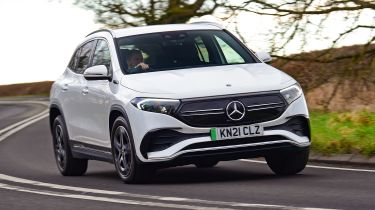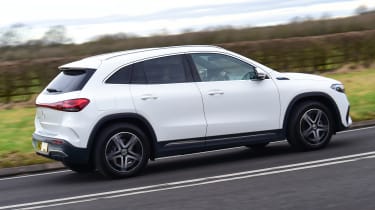Mercedes EQA review: performance, motor & drive
The Mercedes EQA is a quiet and predictable car to drive, but it’s not much fun; rivals are more engaging
| Model | 0-62mph | Top speed | Driven wheels | Power |
|---|---|---|---|---|
| EQA 250+ | 8.6s | 99mph | Front | 187bhp |
| EQA 300 4MATIC | 7.7s | 99mph | Four | 225bhp |
| EQA 350 4MATIC | 6.0s | 99mph | Four | 288bhp |
Some of the quickest and fastest cars ever made are powered by electricity, however, the Mercedes EQA is not one of them. That’s not to say the EQA is mind-numbingly slow; even the base front-wheel drive model is more powerful than your average petrol-powered family SUV, with the electric motor providing instant torque off the line. Then there are the all-wheel-drive versions which pack even more of a punch.
Instead, the EQA’s real strength is its refinement. There’s no double glazing like you’ll find in its bigger brother, the EQC, so you’re more at the mercy of wind and road noise on the motorway – but for the most part, it’s a relaxing car to drive.
Mercedes EQA 0-62mph, top speed and acceleration
You’d think with only 187bhp – less than half what the larger and more expensive EQC has – that the entry-level EQA 250+ might feel a bit lethargic. And yet it really doesn’t. Or at least that’s our experience of this car’s identically-powered predecessor, the EQA 250.
The entry-level EQA was actually updated in 2022 with a larger battery, but the 187bhp motor used to power drive the front wheel was unchanged. Mercedes claims 0-62mph is taken care of ever-so-slightly faster though; the new EQA 250+ cuts the benchmark sprint by three-tenths of a second from 8.9 to 8.6 seconds in the old EQA 250. In the world of electric cars it doesn't sound that fast, but in reality it’s plenty quick enough for a car of this type.
Our drive of the pre-update battery and motor combination was a largely positive experience. The EQA felt much lighter on its toes than the EQC and arguably more fun as a result. With plenty of torque for overtaking, it’s certainly no slouch.
We found there was plenty of zip from a standstill and even at faster speeds you’ll feel a tangible surge of power when you put your foot down. The fact this Mercedes tops out at just 99mph is neither here nor there; you’ll find the EQC is more than capable of keeping up with traffic on the motorway.
Faster dual-motor EQA 300 4MATIC and EQA 350 4MATIC models are also offered, with 225bhp and 288bhp respectively. The 300 will do 0-62mph in 7.7 seconds, which is not all that much faster than the base single-motor car, while the 350 slashes that time to six seconds flat. However, you will have to trade some of the 250+’s range for the extra performance as both 4MATIC models use a slightly smaller battery.
Handling
We’ve yet to drive the newly introduced EQA 250+, but we don’t expect much will have changed dynamically in the upgrade from its predecessor, the EQA 250. The entry-level, front-wheel drive EQA goes about its business in a safe and predictable fashion, behaving much like a conventional petrol or diesel model the majority of the time.
Overall, we found the EQA 250 was a very easy car to drive. Power is plentiful but not excessive, while the light steering allows you to turn even tighter than the EQA’s 11.4-metre turning circle suggests. The car was also very stable when we took it out on the motorway, and refinement generally was good.
However, we did notice the motor produces a high-pitched whine under harder acceleration. It was an annoyance more than anything else, but not something we experienced driving the EQA’s key rivals from Audi, BMW or Volvo. The throttle was occasionally difficult to modulate as well, which meant maintaining constant speed in town traffic was harder than it should've been.
The regenerative braking system is very effective at least. Operated via the paddles on the steering wheel, there are several settings to choose from. In its strongest mode you can largely drive the EQA by merely modulating the accelerator; when you do need the brake pedal, it has a more natural feel than the EQC’s. Overall then, it feels like Mercedes has played it safe, without any detriment to the overall package. We reckon most buyers coming from petrol SUVs will find it a pretty pleasing car to drive.
Our test car came fitted with adaptive suspension which is standard on top-of-the-range models. However, in reality, the different modes did little to change the car’s personality. Even in the sportier settings the car displayed the level of compliance you’d expect of a family SUV. The trade-off is precious little difference through the corners where the EQA is prone to understeer. If you want something more engaging to drive, the new BMW iX1 may be the EV for you.
The two more powerful EQA 300 and EQA 350 models both come with two motors for 4MATIC all-wheel drive, though we’ve not had a chance to test these yet. We expect a small improvement in grip over cold or wet roads, but a similar driving experience at slower speeds or when driving around town. The biggest difference is likely to be performance, with the flagship 350 offering prodigious straight-line speed – at least on paper.





